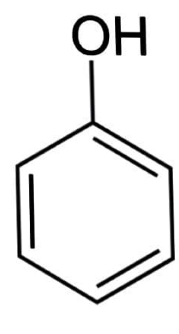
The correct order of increasing acidic strength is:
A.Phenol < ethanol < chloroacetic acid < acetic acid
B.Ethanol < phenol < chloroacetic acid < acetic acid
C.Ethanol < phenol < acetic acid < chloroacetic acid
D.Chloroacetic acid < acetic acid < phenol < ethanol
Answer
495.6k+ views
Hint: In general, the stability of an acid's conjugate base is exactly proportional to the acid's strength in an organic molecule. To put it another way, an acid with a more stable conjugate base is more acidic than one with a less stable conjugate base.
Complete answer:
Phenol: The aromatic organic chemical phenol (also known as carbolic acid) has the chemical formula \[{C_6}{H_5}OH\]. It is a flammable white crystalline substance. A phenyl group \[\left( {{C_6}{H_5}} \right)\] is connected to a hydroxyl group \[\left( {OH} \right)\] in this molecule. It's mildly acidic and should be handled with caution because it can cause chemical burns.

Ethanol: Ethanol, commonly known as ethyl alcohol, grain alcohol, or alcohol, is a member of the alcohol class of chemical substances with the chemical formula \[{C_2}{H_5}OH\]. Ethanol is a common industrial chemical that is used as a solvent, in the production of other organic compounds, and as a fuel additive (forming a mixture known as a gasohol).
Chloroacetic acid: The halogenated aliphatic carboxylic acid chloroacetic acid is commonly used as a herbicide and preservative. Its mutagenic effects in Rattus norvegicus have been investigated.
Acetic acid: Acetic acid, commonly known as ethanoic acid is a colourless acidic liquid and organic substance having the chemical formula \[C{H_3}COOH.\]Apart from water, vinegar contains no less than \[4\% \] by volume, making acetic acid the most important component.
Ethanol < Phenol < Acetic acid < Chloroacetic acid are the correct order of increasing acidic strength. Because the phenoxide ion formed during deprotonation is stabilised by resonance in phenol, it is more acidic than ethanol. When it comes to ethanol, however, resonance stabilisation is not achievable. Similarly, because the carboxylate ion is stabilised by resonance, carboxylic acids are more acidic than alcohols and phenols. Because of the inductive effect of the chlorine atom, which stabilises the carboxylate anion, chloroacetic acid is more acidic than acetic acid.
So, option (C) is correct.
Note:
Phenols are frequently used in domestic items and as industrial synthesis intermediates. For example, phenol is used as a disinfectant in home cleaners and mouthwash (at low doses). Phenol may have been the first antiseptic used in surgery.
Complete answer:
Phenol: The aromatic organic chemical phenol (also known as carbolic acid) has the chemical formula \[{C_6}{H_5}OH\]. It is a flammable white crystalline substance. A phenyl group \[\left( {{C_6}{H_5}} \right)\] is connected to a hydroxyl group \[\left( {OH} \right)\] in this molecule. It's mildly acidic and should be handled with caution because it can cause chemical burns.

Ethanol: Ethanol, commonly known as ethyl alcohol, grain alcohol, or alcohol, is a member of the alcohol class of chemical substances with the chemical formula \[{C_2}{H_5}OH\]. Ethanol is a common industrial chemical that is used as a solvent, in the production of other organic compounds, and as a fuel additive (forming a mixture known as a gasohol).
Chloroacetic acid: The halogenated aliphatic carboxylic acid chloroacetic acid is commonly used as a herbicide and preservative. Its mutagenic effects in Rattus norvegicus have been investigated.
Acetic acid: Acetic acid, commonly known as ethanoic acid is a colourless acidic liquid and organic substance having the chemical formula \[C{H_3}COOH.\]Apart from water, vinegar contains no less than \[4\% \] by volume, making acetic acid the most important component.
Ethanol < Phenol < Acetic acid < Chloroacetic acid are the correct order of increasing acidic strength. Because the phenoxide ion formed during deprotonation is stabilised by resonance in phenol, it is more acidic than ethanol. When it comes to ethanol, however, resonance stabilisation is not achievable. Similarly, because the carboxylate ion is stabilised by resonance, carboxylic acids are more acidic than alcohols and phenols. Because of the inductive effect of the chlorine atom, which stabilises the carboxylate anion, chloroacetic acid is more acidic than acetic acid.
So, option (C) is correct.
Note:
Phenols are frequently used in domestic items and as industrial synthesis intermediates. For example, phenol is used as a disinfectant in home cleaners and mouthwash (at low doses). Phenol may have been the first antiseptic used in surgery.
Recently Updated Pages
Master Class 11 Business Studies: Engaging Questions & Answers for Success

Master Class 11 Computer Science: Engaging Questions & Answers for Success

Master Class 11 Maths: Engaging Questions & Answers for Success

Master Class 11 Chemistry: Engaging Questions & Answers for Success

Master Class 11 Economics: Engaging Questions & Answers for Success

Master Class 11 Accountancy: Engaging Questions & Answers for Success

Trending doubts
What is meant by exothermic and endothermic reactions class 11 chemistry CBSE

10 examples of friction in our daily life

One Metric ton is equal to kg A 10000 B 1000 C 100 class 11 physics CBSE

1 Quintal is equal to a 110 kg b 10 kg c 100kg d 1000 class 11 physics CBSE

Difference Between Prokaryotic Cells and Eukaryotic Cells

What are Quantum numbers Explain the quantum number class 11 chemistry CBSE




